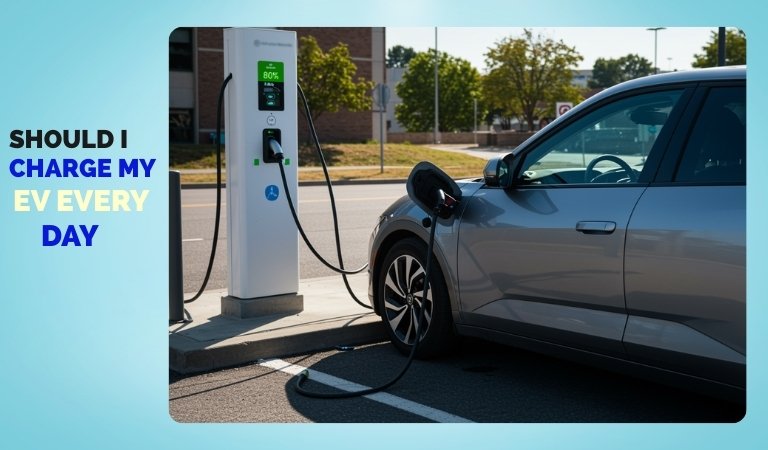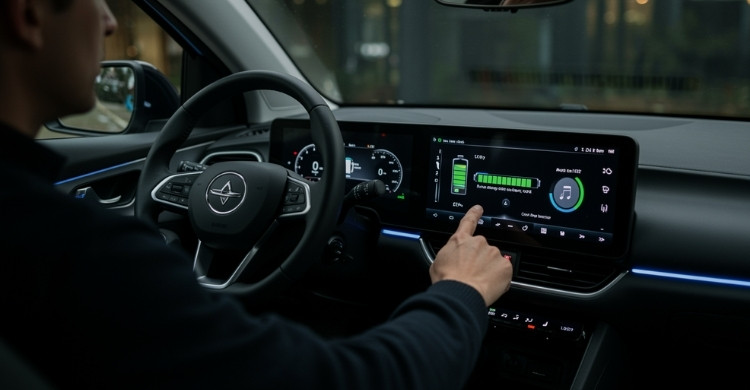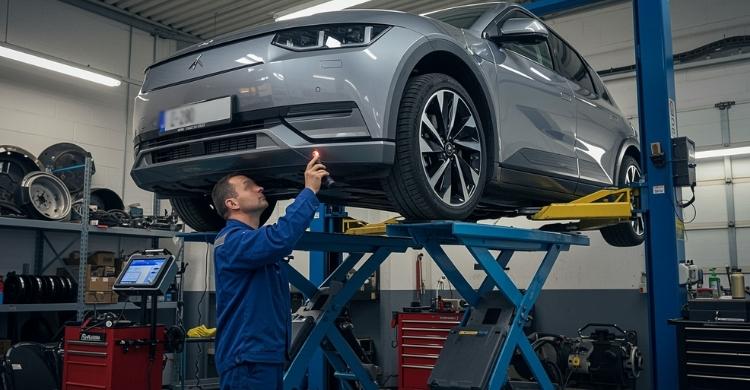Nowadays, electric vehicles (EVs) are becoming an essential part of modern transportation, offering an eco-friendly alternative to traditional gas-powered cars. As EVs gain popularity, many drivers are left wondering, “Should I charge my EV every day?”
You don’t need to charge your EV every day. Charge based on your battery level, driving habits, and the manufacturer’s advice. Daily charging is only needed if your commute drains most of the battery. Frequent full charges can reduce battery lifespan, so charging when needed is usually best.
In the following sections of this article, we’ll dive deeper into how to establish the best charging routine for your electric vehicle and optimize battery health. So read on for more information.
Should I Charge My EV Every Day? (Efficient EV Charging)
Electric vehicles (EVs) offer a sustainable and efficient mode of transportation, but charging them can be confusing. Many drivers wonder if daily charging is necessary or if it’s better to charge based on needs. The truth is, daily charging isn’t required for most EV owners. Read below to discover the key factors that impact your charging routine:

Battery Level
Your EV’s battery level directly impacts when it’s time to charge. It’s best not to wait for the battery to be completely empty. Charging once it drops to 20-30% helps preserve battery health. Consistently charging too low or too high can reduce the battery’s overall lifespan.
Driving Habits
The distance you drive each day influences your charging routine. If your daily commute drains most of the battery, more frequent charging is necessary. Shorter trips may not require daily charging, extending the time between charges. Keep an eye on how much energy you use throughout the week.
Manufacturer’s Guidelines
Each EV has specific manufacturer guidelines for charging that should be followed. These instructions are designed to maximize battery efficiency and lifespan. Consult your vehicle’s manual to understand the recommended charging practices. Staying within these guidelines helps avoid premature wear and tear on the battery.
Type of Charging
The type of charger you use plays a role in battery health. Using a crack platoon ev charger or any high-speed option can be convenient. However, fast charging may degrade the battery faster than slower alternatives. Standard home chargers are gentler and better for long-term battery care.
Frequency of Full Charges
Charging to 100% regularly isn’t always necessary. Charging fully too often can stress the battery and reduce its longevity. It’s better to keep the battery level between 20-80% to maintain its health. Frequent full charges may lead to quicker battery wear over time.
Weather Conditions
Extreme temperatures can significantly affect your EV’s performance and charging needs. Cold weather might cause higher energy consumption, requiring more frequent charges. On the other hand, hot weather can speed up battery degradation. Be mindful of temperature extremes when planning your charging schedule.
By considering these factors, you can establish an efficient charging routine that maximizes your EV’s battery lifespan and keeps it running smoothly. Over time, this smart approach can also help you save on electricity costs and reduce unnecessary strain on your vehicle.
Charging Myths That Could Be Hurting Your EV
With the rise of electric vehicles, misinformation about charging has become surprisingly common. Believing in these myths can impact your EV’s performance and efficiency. Here are some charging myths you should stop trusting to protect your vehicle and its battery:
- Charging Overnight Always Damages the Battery: Smart EV systems are designed to stop charging once full, so overnight charging doesn’t always cause harm if managed properly.
- Only Fast Charging Is Worth It: Relying solely on fast charging adds heat stress, reducing long-term battery health compared to slower, more consistent charging methods.
- You Must Always Charge to 100%: Keeping your battery near full all the time can create unnecessary strain and slightly reduce its total lifespan over time.
- It’s Fine to Let the Battery Hit 0%: Allowing the battery to completely drain frequently risks permanent capacity loss and puts strain on the battery management system.
- All Chargers Work the Same Way: Different chargers provide varying voltages and speeds, which directly affect charging time, efficiency, and even battery wear levels.
- Colder Temperatures Don’t Affect Charging: Charging in cold climates can slow energy flow and reduce efficiency, which leads to longer charge times and potential performance drops.
- Charging While Parked for Long Periods Is Best: Leaving your EV plugged in too long without use may stress the battery, especially if it stays at high charge levels.
- Using Public Chargers Always Costs More: Many public stations offer affordable rates or free access, depending on region, time of day, or subscription plans available.
- Turning the Car On While Charging Is Dangerous: Modern EVs are built with safety systems that allow limited use during charging without causing damage or safety issues.
- You Should Always Use the Manufacturer’s Charger: While manufacturer chargers are reliable, certified third-party chargers meet safety standards and work just as well in most cases.
How to Monitor Your EV Battery Levels Effectively?
When you own an electric vehicle (EV), keeping track of your battery level is super important for smooth rides. Knowing when to charge and how much battery you have left helps you avoid unexpected breakdowns. Here are simple tips for checking the health of your electric vehicle’s batteries.

Battery Indicator on Dashboard
Most EVs show the battery level right on the dashboard, just like a fuel gauge in regular cars. The level is usually shown as a percentage, so it’s easy to understand. When it’s low, it’s time to find a charging station. Make sure to check it before leaving for long trips.
Mobile Apps for Monitoring
Many EVs have apps that let you check the battery status directly from your phone. These apps also send alerts when your car needs charging. Some even let you start charging remotely or set a charging schedule. It’s a quick and easy way to stay on top of your battery level.
Charging Station Maps
When you’re driving, you might wonder where to charge your EV. There are maps available that show nearby charging stations. This way, you can plan your trip and know when and where to stop for charging. Keep the map handy, especially for longer drives.
Energy Consumption Display
Some EVs show how much energy you’re using while driving. This display helps you understand how far your battery will last based on your current driving speed and habits. By checking it, you can adjust your driving style to conserve more energy and make the battery last longer.
Charging Schedule
To avoid overcharging or undercharging your EV, it’s best to set a regular charging schedule. Sticking to an ideal EV battery charging threshold helps maintain long-term battery health and avoid stress. Charging every day at the same time can make things easier. Many EVs allow you to set a time for charging, so it doesn’t use energy during peak hours or when you’re not home.
Battery Health Checks
Over time, EV batteries can lose some of their original capacity. Regular checks on the battery health can give you an idea of how well it’s performing. If your battery is showing signs of wear, it’s a good idea to consult with a mechanic or your vehicle’s service center.
Benefits of Charging EV Daily vs. Weekly
How often you charge your electric vehicle can make a big difference in how it performs and lasts over time. Some people prefer daily charging, while others go for weekly top-ups. Here’s a simple table comparing the benefits of both charging styles.
| Point | Daily Charging | Weekly Charging |
| Convenience | Always ready to go with a full battery. | May need planning if the battery runs low. |
| Battery Level Stability | Keeps the battery within optimal range daily. | Battery level may drop too low before charging. |
| Range Confidence | Peace of mind with enough range every day. | May feel range anxiety as battery drains. |
| Time Management | Shorter charging times more often. | Longer charging sessions, but less frequent. |
| Battery Wear | Frequent top-ups can reduce deep discharges. | Fewer cycles, but deeper discharges may affect battery health. |
| Charging Costs | May take advantage of off-peak daily rates. | Can schedule charging for the cheapest time once a week. |
| Trip Readiness | Great for unexpected trips. | Need to plan ahead for sudden long drives. |
| Charging Habit | Becomes a part of your daily routine. | Easy to forget or delay charging. |
| Vehicle Monitoring | Better tracking of battery use and condition. | Less frequent check-ins may miss battery issues. |
| Energy Efficiency | Keeps EV operating in ideal charge zones. | May spend more energy if the battery gets too low. |
Things To Do If Your EV Won’t Charge Properly
Sometimes your electric car may not charge the way it should, and that can feel a little stressful. There could be a few simple reasons behind it. Fortunately, most of these problems can be solved easily. Here is what you can do if this happens to you.

Check the Charging Cable
Start by checking your charging cable. Make sure it’s not bent, damaged, or twisted in any way. Both ends should be plugged in properly and firmly. Look inside the plug to see if there’s dirt or dust. Cleaning it gently might help it work again.
Look at the Power Source
Make sure the socket you’re using has power. You can test it by plugging in a different device, like a lamp. If the lamp doesn’t work, the problem is with the power source. Sometimes a breaker switch turns off, and flipping it back can fix the issue. Asking an adult for help here is a good idea.
Restart the EV
Turning the EV off and on again can fix small charging problems. Wait for a minute after turning it off before starting again. This helps reset the system in the car. Many EVs fix small errors just by restarting. Think of it like restarting a phone that’s acting weird.
Try a Different Charger
Use another charger nearby to see if your car charges there. Charging stations at malls or public places can be useful for this. If the car works fine there, your home charger might be the problem. That helps you know where to look next. Borrowing a friend’s charger can also help you check.
Check the Settings
Open your EV’s screen or app and look at the charging settings. Sometimes there’s a limit set that stops charging early. There may also be a timer that delays charging. These settings can be changed easily. Make sure everything looks normal and try charging again.
Contact Support
If nothing works, talk to the car company’s support team. They know how to troubleshoot EV charging issues and give the right advice. You can also visit a service center for help. Getting help is better than guessing and making things worse. Support staff are friendly and trained to solve these problems.
FAQs About Should I Charge My EV Every Day?
As electric vehicles (EVs) become increasingly popular, many new owners have questions about the best charging practices. Below, we’ve compiled some frequently asked questions to help you better understand how to properly care for your EV’s battery.
Can I Charge My EV Using a Regular Home Outlet?
Yes, you can charge your EV using a standard 120V home outlet, but it will take longer than using a dedicated 240V charger. This method is known as Level 1 charging and is ideal for overnight charging when you don’t need to recharge quickly.
Will Charging My EV During Off-peak Hours Save Money?
Charging during off-peak hours can save you money if your electric utility offers time-of-use (TOU) rates. These rates are lower during times of day when electricity demand is lower, typically overnight. Many EV owners take advantage of these times to reduce their electricity bills.
How Long Does It Take to Charge an EV Fully?
The time it takes to fully charge an EV depends on the charging method and battery size. Using a Level 1 charger (standard outlet), it could take over 24 hours for a full charge. A Level 2 charger (240V) takes between 4 to 8 hours, while DC fast charging can provide an 80% charge in around 30 minutes.
What Happens if I Overcharge My EV Battery?
Overcharging can lead to battery overheating, reducing the battery’s life. Most EVs are designed with built-in safeguards to prevent overcharging, but consistently charging to 100% can still lead to gradual wear. It’s best to avoid charging fully on a regular basis and keep the battery within a healthy range.
How Do I Know When My EV Needs Charging?
Most EVs provide a clear battery indicator on the dashboard, which shows the remaining charge. Additionally, mobile apps linked to your EV can offer real-time updates on battery status. Some EVs also provide alerts when the charge is getting low, so you can plan your next charging session.
How Often Should I Perform Maintenance on My EV’s Battery?
EV batteries typically require little maintenance, but regular checks are recommended to monitor battery health. Some EV manufacturers recommend checking the battery every 12,000-15,000 miles or once a year. Always follow the manufacturer’s maintenance guidelines for the best results.
Can I Use My EV While It’s Charging?
Yes, you can generally use your EV while it’s charging. Modern EVs allow limited functionality while charging, such as using air conditioning or navigation. However, it’s best to avoid excessive power use during charging to avoid overloading the system and prolong battery life.
Bottom Line
Driving an electric vehicle is smart, sustainable, but understanding how to care for the battery is equally important. One of the most common concerns EV owners have is: Should I charge my EV every day? The answer isn’t one-size-fits-all. It depends on how much you drive, your battery’s condition, and your charging setup.
Charging every day might be convenient, but it’s not always necessary. In fact, frequent full charges could slowly wear down your battery’s life over time. On the flip side, letting the battery run too low too often can also cause strain. You need to find a balance based on your daily usage and follow manufacturer guidelines.
Overall, charging routines should fit your lifestyle, not the other way around. Pay attention to your driving patterns, stay informed, and treat your battery with care. That way, you’ll keep your EV running smoothly for years to come.
